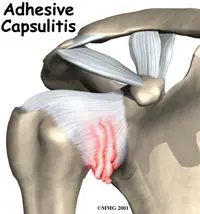Treatment for Frozen Shoulder in Seattle
 Frozen shoulder is a general term used to describe all causes of motion loss in the shoulder. The most common cause of loss of motion is a condition known as adhesive capsulitis. The joint capsule is a watertight sac that encloses the joint and the fluid that lubricates it. With adhesive capsulitis, the shoulder capsule becomes stiff, leading to limited range of motion of the shoulder. The shoulder capsule becomes stiff because of a combination of inflammation and fibrosis (scarring of the capsule).
Frozen shoulder is a general term used to describe all causes of motion loss in the shoulder. The most common cause of loss of motion is a condition known as adhesive capsulitis. The joint capsule is a watertight sac that encloses the joint and the fluid that lubricates it. With adhesive capsulitis, the shoulder capsule becomes stiff, leading to limited range of motion of the shoulder. The shoulder capsule becomes stiff because of a combination of inflammation and fibrosis (scarring of the capsule).
Why people develop adhesive capsulitis is, for the most part, unknown. Women are more commonly affected than men. Risk factors include diabetes, thyroid disease, and heart disease, however, the majority of people who develop adhesive capsulitis have no known risk factors.
What Causes a Frozen Shoulder?
Frozen shoulder typically happens through a physical cause. The shoulder is a very susceptible area on the body, so physical causes are common and can happen at any age:
Physical injury – This happens a lot to athletes who participate in high contact sports, such as football, hockey and lacrosse. A hard hit to that area can damage the intricate and delicate tendons in the shoulder. Additionally, twisting and spraining injuries can create a frozen shoulder, too. This can be from other sports that use the shoulder such as gold or tennis, or any common activity like yard work or heavy lifting.
The shoulder was immobilized for a long period of time – After an injury, you may have to rest your shoulder for weeks or even months at a time depending on the injury. During this process, the muscles and tendons tend to lock up. However, these are usually more mild cases of frozen shoulder. It is suggested you do exercises recommended by your physical therapist to avoid a frozen shoulder during recovery. With some exercises and stretching, a frozen shoulder caused from this should go away.
Treatment Options
Adhesive capsulitis is traditionally divided into 3 phases.
Phase 1:
Inflammatory/Pre-Freezing Phase
During this phase the shoulder is very painful when in active and passive motion and range of motion is only limited by pain. You’ll also feel aching when you’re not moving your shoulder as well. Typically, you’ll lose motion when you rotate your arm away from your body (external rotation) and when you raise your arm or reach behind your back (internal rotation). At this point, it’s pretty difficult to say for certain if you have adhesive capsulitis. This phase typically lasts several months.
Phase 2:
Freezing Phase
The shoulder capsule becomes progressively stiff during this phase and true limitation of motion develops. By the end of this phase, the shoulder is very stiff but is only painful at the end ranges of motion. This phase usually lasts 3-9 months.
Phase 3:
Thawing Phase
In this phase, the shoulder range of motion and pain progressively improve. This phase typically lasts 1-2 years. Near the end, you’ll begin to go back to your daily activities as normal. The entire process can take 2-3 years or more to resolve.
Treatment for adhesive capsulitis includes anti-inflammatory medications and physical therapy to try to maintain or improve motion. An injection of cortisone into the shoulder can, sometimes, stop the inflammation. Patients will require an arthroscopic procedure to break up the scar tissue.
Schedule a Frozen Shoulder Consultation
To schedule an appointment for frozen shoulder treatment in the Seattle, WA area, contact shoulder surgeon Samuel Koo today. Dr. Koo performed more than 375 shoulder surgeries last year, and he may be able to help you, too. Give our Kirkland office a call at (425) 823-4000 or request an appointment through our secure online form. We’re located just a short drive from Seattle, Bellevue, and Redmond.

